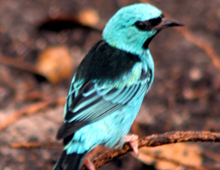Description: The base of the recurved, conical bill and the legs are pink. The eyes are dark red. The male is turquoise blue overall with the throat, shoulders, wing-bars and tail being black. The female is also quite striking, with shades of green and a blue crown.
Size: The length of the Blue dacnis is approximately five inches (12.7 cm); weight is 0.46 ounce (13 gr).
Behavior: They normally are alone or paired and rarely in small groups. They will flock with other species, such as honeycreepers and tanagers. They appear restless when foraging, which is how they spend the majority of their time.
Diet: The diet consists mainly of insects, fruits, nectar and seeds.
Senses: Eyesight allows for the birds to note brown spots on leaves which often indicates the presence of an insect.
Communication: Infrequently repeats a lispy “tsit” high-pitched notes.
Reproduction: The Blue dacnis nests from January to September. The nest is a deep cup made from different plants, normally suspended from tree forks about 18 to 25 feet (5.5-7.6 m) above the ground. They usually lay two eggs (whitish with dark marks).
Habitat/range: Found from Nicaragua to Argentina, Blue dacnis prefer forest edges, open woodlands, scrub and second growth. They can be found from the lowlands to 4,000 feet (1,219 m) above sea level.
Status: The Blue dacnis is a common bird and is not endangered; IUCN status is Least Concern.



